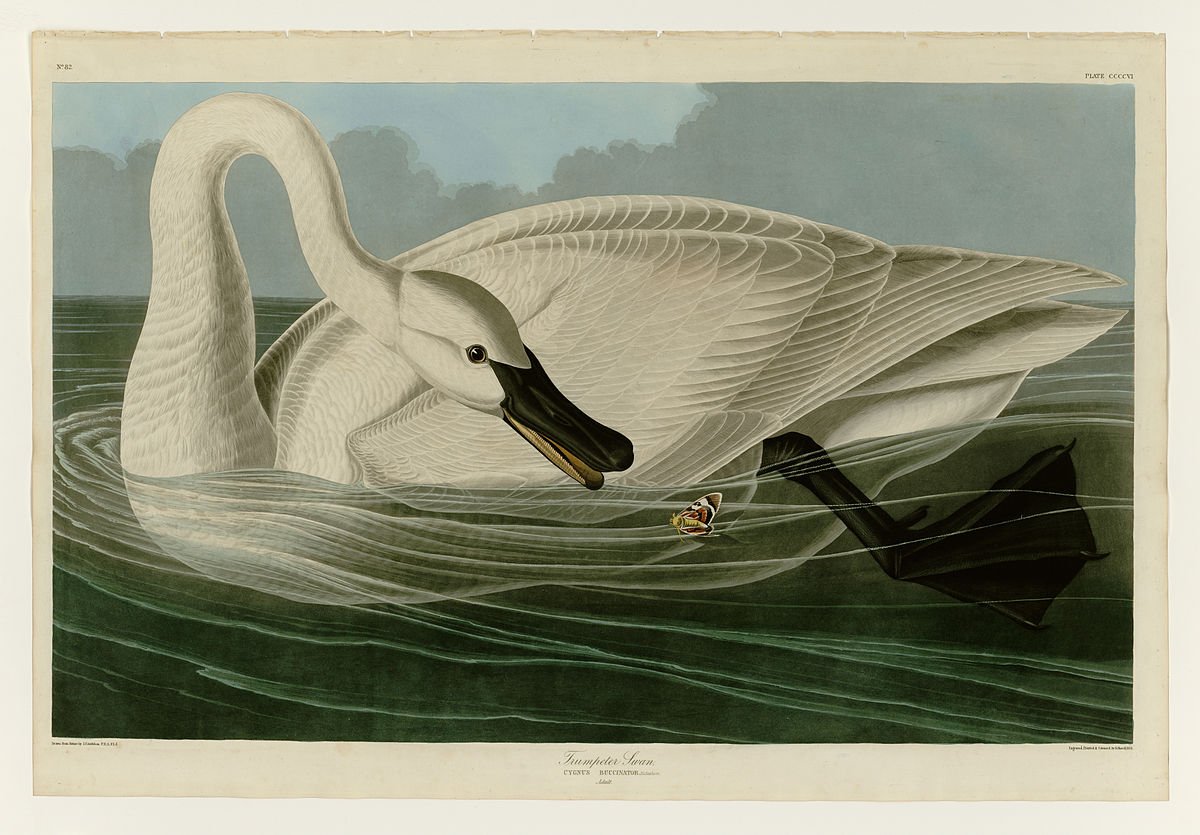
Many years ago, back in the 1970s, I visited my sister, who lived in West Yellowstone, Montana, in the dead of winter. We rented snow mobiles and drove into Yellowstone. That was the only way to get into Yellowstone in the winter (other than walking). You either rented a snowmobile or you took the big giant snowmobile bus (called a snow coach as I recall).
At one point we came to an overlook of a stretch of the river. It was the Madison River, downriver from the confluence of the Firehole. Out on the river were about 40 or so swans. My sister told me they were Trumpeter Swans (Cygnus buccinator). All of them. Or almost so. Only several dozen of these swans wintered in the region (the region being, approximately, Montana, Idaho and Wyoming) and for some reason they were almost all at this river in this year, and on this day, they were right there in view.
Of course there were other Trumpeter Swans out there, but not many. Canada has more than the US. There are a lot in the Mississippi Flyway these days. Around the middle of the 20th century they had almost gone extinct. They were heavily hunted as food, and for the feathers. Over the last few decades they have made something of a comeback, still not nearly as common as they once were. Here in Minnesota they are listed as threatened. It happens that our lake (well, it’s not our lake, but the lake were the cabins are) has a small bay that is a stopover for Tundra Swans, and as of late, Trumpeter Swans have been showing up and hanging around.
Trumpeter Swans are the largest extant waterfowl. Their wing span can be up to eight feet. They eat aquatic vegetation, including, interestingly, roots of aquatic plants. Apparently, one of them once ate a moth or something (see illustration) but really, they are mainly plantivores. Overall they are pretty amazing birds.
And apparently they are getting gunned down on a regular basis in Minnesota.
During this year’s open of waterfowl season, the Wildlife Rehabilitation Center admitted more trumpeter swans for bullet wounds than ever before.
…The number of swans admitted to the hospital this fall is still low, currently standing at eight, but the DNR said that’s still higher than usual. …Veterinarian hospital workers in Roseville see projectile wound, or bullet wound, injuries quite frequently.
…
It’s illegal to shoot trumpeter swans in Minnesota.
The executive director of the Wildlife Rehab Center, Phil Jenni, isn’t sure if [a particular shooting] shooting was intentional.
“There were other people in the vicinity who witnessed the swans flying into the water and being shot,” said Jenni,…DNR non-game wildlife specialist Lori Naumann believes the higher number of trumpeter swans visiting the hospital this season is for two reasons.
“They (hunters) see this white thing, and they aren’t entirely sure what it is,” Naumann said.
The other reason is due to inexperienced or uninformed hunters. Regardless, the DNR is trying to do its best to make sure trumpeter swans don’t become regular visitors at WRC.
Three hunters have been charged. However, a DNR conservation officer said the case is still open because not all the fines have been paid. A fine for shooting a trumpeter swan is around $1,200.
So. You see this big white thing and, of course, you shoot it.
This problem is, of course not unique to Minnesota.
Great Trumpeter Swan birding report HERE. Occasionally things can go badly wrong.













Perhaps you could also do an article on lead core bullets and scavenger birds.
I was reminded of something long past by the citation in the article “They (hunters) see this white thing, and they aren’t entirely sure what it is,” Naumann said.
Many years ago when I was a volunteer for the California Department of Fish and Game and had to check the hunters leaving a wildlife “refuge” in Southern California we found one duck hunter that had bagged a great blue heron of all things.
He also claimed not to know what it was, but killed the creature anyway.
Thank you for this post. I just saw nine Trumpeter Swans in a small lake here on the Olympic Peninsula, and felt so lucky to see them!
Thanks, Greg. I missed this.
I’m always somewhat surprised that hunters who are out there because they enjoy the natural world and seeing critters shoot when they should know better (Of course, some don’t care one way or another). And to learn a little more about them (something I should do as well).
This post reminded me, too., of E. B. White’s lovely book,a long time favorite.
Laura, swans are affected by lead, apparently. That would be an interesting article to research.
The swans could be affected by ingesting illegal lead shot while feeding. Vultures, eagles and other scavengers pick up tiny bits of lead fragments in gut piles, carcasses and such. Of course, if the lead is in the water, we’re all up the creek.
There are literally hundreds of tons of lead shot in waterways across North America, the result of several hundred years of waterfowl hunting. It is only very recently, 1991 for the US and 1999 for Canada (all migratory birds not just waterfowl) that steps have been taken to make waterfowl hunting with lead shot illegal. Then there is all the lead from fishing weights as well